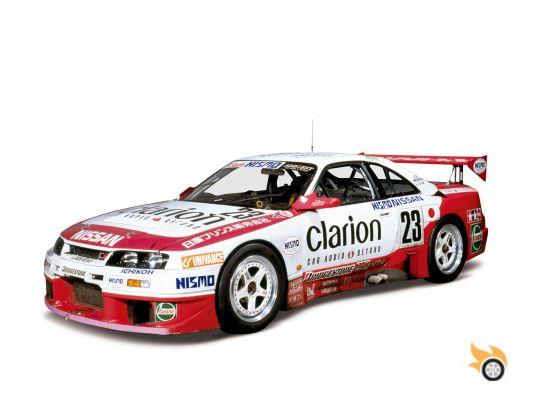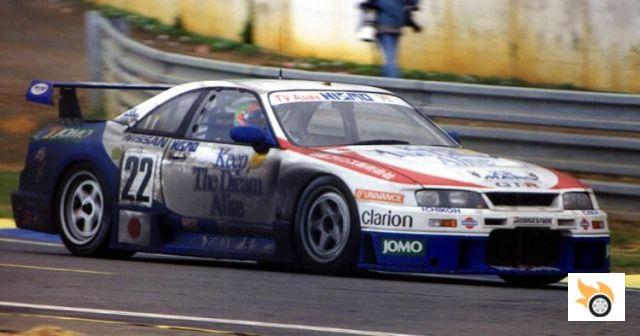In January 1995 the new R33 finally went into production. Under its front hood was an evolution of the familiar RB26DETT debuted in the R32. It retained virtually all the features of the R32 engine, such as its six-cylinder, 26-litre, twin-supercharged engine. The oil pump was replaced by one with a higher flow rate, to improve reliability in the face of high demands.

The GT-R V-Spec featured an intelligent rear differential to actively distribute torque to the rear wheels and improve vehicle yaw.
The car was offered in two specifications, the normal and the sportier Victory Spec (V-Spec). On paper, the car's entire lineup was quite similar, with all-wheel drive, four-wheel independent suspension and slightly larger dimensions. But there were new features in its two main systems that made it the monster it was.
On the one hand, the ATTESA E-TS all-wheel drive system received a "Pro" variant for the V-Spec. This variant replaced the mechanical self-locking rear differential with an electronically controlled one, capable of choosing how much torque to send to each of the rear wheels under acceleration or hold, further improving the car's ability to turn and pull. In addition, the HICAS rear axle active steering became fully controlled by the on-board computer, along with a new ABS system.
All together it created a powertrain that at the time was far more advanced than what was available from rival marques.
Interestingly, when his prototype was unveiled in 1993, the new GT championship, the All-Japan GT, was debuting in Japan, designed specifically to prevent the dominance of the R32. But an R32 modified according to the allowed rules took the win ahead of machinery like the Ferrari F40 or the Porsche 962.

The GT-R R33 would go on to win the JGTC in the GT500 class in '95 and '98.
For 1995 the new R33 could be used for the first time on the circuit, and the organizers, in order to avoid the dominance of the R32 and the situation created in the All-Japan GT, set up the GT500 category, allowing more modifications than the standard cars and prohibiting active four-wheel drive in a clear attempt to eliminate the competitive advantage of the GT-R. It didn't matter, as the R33 debuted that season as a good GT-R, winning the championship in the first race.
After that inaugural victory, the evolution of the cars of the competition was brutal, and Nissan lost the titles of 96 and 97, until it was encouraged to create a real racing machine, modifying the chassis and engine position, and mounting a variant of elongated displacement of the RB26DETT (the RB28DETT), with which he regained the championship in 1998.
But this special is about Le Mans, and Le Mans with the GT-R has finally arrived. For 1995, the ACO set up the GT1 category. The idea was to turn the endurance race into a runway where street-registered, homologated cars would race, something we still find beautiful and interesting today. The problem is that the ACO reduced the homologation requirements to a single registered unit, and in the medium term this ended up implying the construction of racing cars registered "by the skin of their teeth" from 1997 onwards. But that's another matter.

GT-R R33 LM, "license plate" version
For 1995, Nissan decided to send a pair of GT-R R33s to race at Le Mans under Nismo management. It's worth remembering that, as we told you the day before yesterday, in 1994 their 300ZX had won the GTS class, and they were hoping to achieve something similar with the GT-R.
The R33 was prepared for the competition through a special edition, called GT-R LM. It was a single unit, with wider track width, a specific aerodynamic design, and changes in the drive system, as it was dispensed with all-wheel drive in favor of a rear-wheel drive system that allowed the car to run with fewer kilos in competition. After all, Le Mans was not a circuit where having all-wheel drive, at least in dry conditions, was a differentiating factor.
The only unit registered for the street was registered in the UK under the very permissive regulations of the SVA (unitary homologation), remaining in the possession of Nissan. Meanwhile, two other units were prepared for competition. One, car #22, featured the RB26DETT N1, the standard GT-R engine, slightly evolved for Group N racing (slightly thicker block walls, turbochargers without ceramic bearings to be less fragile), while car #23 received an engine with a displacement stretched to 2.8 liters. The #22 GT-R thus delivered 400 horsepower to the rear wheels, while the #23 delivered 600.

The GT-R LM ran with an engine very close to the series, but dispensed with the traction system and active all-wheel steering for homologation issues for the race and for minimum weights.
In addition, the #23 car was fitted with a six-speed X-Trac sequence gearbox, while the #22 was fitted with the standard five-speed manual gearbox.
The problem for Nissan was that the McLaren F1 was making an appearance that year, a car that no one expected to see at Le Mans shortly before. And sure enough, the carbon fibre machine from Woking tore the competition apart, dominating the race with an iron fist and taking six of the top ten places overall at the end of the race. The #23 GT-R LM, the "more racing" GT-R abandoned with problems in its X-Trac box, not having been able to test the car properly before the event, while the #22, slower and less powerful, achieved a good tenth place overall, fifth in the GT1 category, only behind the McLaren and the Honda NSX.

Tenth overall and fifth in class were the best results for the GT-R at Le Mans.
For 1996 Nismo decided to participate again with a new evolution of the GT-R LM Nismo. This time it took the same car that was competing in the Japanese GT500, with the 2.8-litre engine and a new sequential gearbox developed by Nissan. But the evolution of the European GT1s was such that, although the Nissan was faster than the previous year, it was no match for them. Unable to take advantage of the attributes that made it a terrible track weapon normally (intelligent all-wheel drive and active steering) the GT-R LM settled for the #23 car with a 15th place overall, and a tenth in its class, leaving the #22 with brake system problems.
Thus, the GT-R would not return to Le Mans. And for 1997 Nissan would put all the cards on the table again with the R390 GT1, which we'll talk about tomorrow. It won't be until this year when GT-R and Le Mans cross paths again.






























